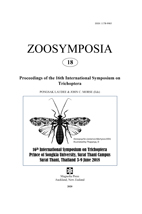Abstract
Trichoptera larvae and adults were collected as part of an overall assessment of aquatic macroinvertebrate diversity in the major headwater tributaries of the Okavango and Zambezi River basins in Angola. This report documents one of the National-Geographic-funded, Okavango-Wilderness-Project expeditions undertaken between October and November 2016. A total of 21 sites on the Cuanavale, Cuito, Cuando, and Cuembo Rivers and some of their tributaries were sampled. Biotopes sampled in source lakes, headwater streams, pools, and large rivers included mostly sandy substrates, aquatic emergent and submerged vegetation, marginal vegetation and (rarely) bedrock, stones, or gravel. Light trap collecting was possible at only seven sites. With both adults and larvae collected, at least 55 species in seven families (Philopotamidae, Dipseudopsidae, Ecnomidae, Hydropsychidae, Hydroptilidae, Leptoceridae, and Sericostomatidae) were recorded. The Leptoceridae were the most abundant family, represented by ten genera and 22 species. There are a number of unnamed species which will be described in a separate paper.
References
Dickens, C.W.S. & Graham, P.M. (2002) The South African scoring system (SASS) version 5 Rapid bioassesment method for rivers. African Journal of Aquatic Science, 27 (1), 1–10.
https://doi.org/10.2989/16085914.2002.9626569
Huntley, B.J. (2017) Wildlife at War in Angola: The Rise and Fall of an African Eden. Protea Book House, Pretoria, 432 pp. ISBN: 978-1-4853-0611-5 (printed book). ISBN: 978-1-4853-0613-9 (ePub).
Marlier, G. (1965) Les Trichoptères du Musée de Dundo. Publicaçòes es Culturais da Companhia de Diamantes de Angola, Lisboa, 72, 13–80.
NGOWP (2018) National Geographic Okavango Wilderness Project (2017): Initial Findings from Exploration of the Upper Catchments of the Cuito, Cuanavale, and Cuando Rivers, May 2015 to December 2016, 368 pp.
Simon, M.F. & Pennington, T. (2012) Evidence for adaptation to fire regimes in the tropical savanas of the Brazilian Cerrado. International Journal of Plant Sciences, 173, 711–723.
https://doi.org/10.1086/665973
White, F. (1979) The Guineo-Congolian Region and its relationship to the other phytochoria. Bulletin Jardin Botanique National de Belgique, 49, 11–55.

